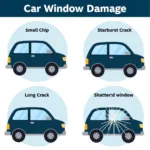Repairing a tear in your woven car seat upholstery can seem daunting, but with the right tools and techniques, you can often fix it yourself and avoid costly professional repairs. This guide will walk you through the process of how to repair woven car seat tear upholstery, from assessing the damage to achieving a seamless finish.
Assessing the Damage and Gathering Your Supplies
Before you begin, carefully examine the tear. Is it a small snag, a large rip, or something in between? The extent of the damage will dictate the best repair method. For minor snags, a simple needle and thread repair might suffice. For larger tears, you’ll likely need a patch and adhesive. Gather the following supplies:
- Upholstery thread matching your car seat color
- Curved upholstery needle
- Upholstery patching material (if needed)
- Fabric adhesive designed for upholstery (if using a patch)
- Scissors
- Small pliers (optional, for gripping the needle)
Repairing a Small Tear Without a Patch
If the tear is small and the edges can be easily brought together, you can repair it without a patch. Thread your needle with upholstery thread, knotting the end. Starting from the underside of the fabric, carefully push the needle through to the front, close to the tear. Then, weave the needle in and out along the edges of the tear, pulling the edges together as you go. Try to keep your stitches small and even for a professional-looking repair.
Remember to knot the thread securely on the underside of the fabric once you’ve finished stitching. Trim any excess thread. This method is ideal for small snags and tears where the fabric hasn’t been significantly lost.
Repairing a Larger Tear with a Patch
Larger tears often require a patch. Cut a patch of upholstery material slightly larger than the tear. Apply fabric adhesive to the back of the patch, following the manufacturer’s instructions. Carefully position the patch behind the tear, ensuring it covers the damaged area completely. Press firmly to adhere the patch to the existing upholstery. Once the adhesive has dried, you can further reinforce the repair by stitching around the edges of the patch using the same technique described earlier. This will help blend the patch into the surrounding fabric and prevent further fraying.
“When choosing a patching material, consider the texture and pattern of your car seat’s upholstery,” advises renowned auto upholstery expert, John Miller. “A close match will result in a more seamless and less noticeable repair.”
Preventing Future Tears
While repairs can be effective, prevention is always the best approach. Regularly cleaning your car seats and avoiding harsh chemicals can help preserve the integrity of the fabric. Using seat covers can provide an extra layer of protection, especially if you frequently transport pets or cargo. Avoid dragging sharp objects across the seats, and be mindful of sharp edges on clothing or accessories.
“Investing in high-quality seat covers can save you from the hassle and expense of upholstery repairs in the long run,” adds Miller. “It’s a proactive step that can significantly extend the lifespan of your car seats.”
Conclusion
Repairing a woven car seat tear upholstery doesn’t have to be a complicated process. By following these steps and taking preventative measures, you can keep your car seats looking their best for years to come. Remember to assess the damage carefully and choose the appropriate repair method for the best results. Don’t be afraid to tackle this project yourself – you might be surprised at how easy and effective it can be!
FAQ
-
What type of thread should I use for car upholstery repair?
Upholstery thread is stronger and more durable than regular thread, making it ideal for this purpose. -
Can I use super glue instead of fabric adhesive?
While super glue might seem like a quick fix, it can damage the fabric and create a stiff, uncomfortable patch. Fabric adhesive is specifically designed for upholstery and provides a more flexible and durable bond. -
Where can I find matching upholstery material for my car?
You can often find matching or similar upholstery fabric at auto upholstery shops or online retailers. Some car manufacturers also sell replacement upholstery material. -
What should I do if the tear is very large or complex?
For extensive damage, it’s best to consult a professional auto upholstery repair service. They have the expertise and tools to handle complex repairs and ensure a high-quality finish. -
How can I prevent my car seats from fading?
Using a UV protectant spray on your car seats can help prevent fading caused by sun exposure. Parking your car in shaded areas can also help.
Need further assistance? Contact us via WhatsApp: +1(641)206-8880, Email: [email protected]. Our customer service team is available 24/7. You can also find more helpful articles like how to repair ripped cloth car seat on our website. We offer a wide range of resources and tips to help you maintain your vehicle and address common car repair issues.


